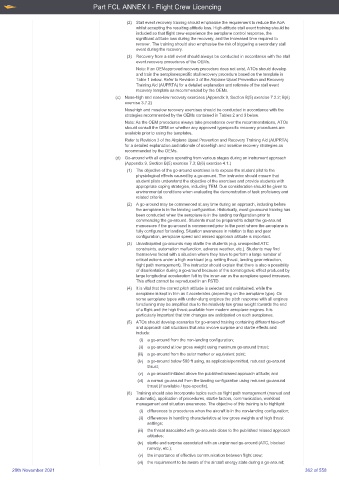Page 362 - UK Aircrew Regulations (Consolidated) 201121
P. 362
Part FCL ANNEX I - Flight Crew Licencing
(2) Stall event recovery training should emphasise the requirement to reduce the AoA
whilst accepting the resulting altitude loss. High-altitude stall event training should be
included so that flight crew experience the aeroplane control response, the
significant altitude loss during the recovery, and the increased time required to
recover. The training should also emphasise the risk of triggering a secondary stall
event during the recovery.
(3) Recovery from a stall event should always be conducted in accordance with the stall
event recovery procedures of the OEMs.
Note: If an OEMapproved recovery procedure does not exist, ATOs should develop
and train the aeroplanespecific stall recovery procedure based on the template in
Table 1 below. Refer to Revision 3 of the Airplane Upset Prevention and Recovery
Training Aid (AUPRTA) for a detailed explanation and rationale of the stall event
recovery template as recommended by the OEMs.
(c) Nose-high and nose-low recovery exercises (Appendix 9, Section B(5) exercise 7.2.2; B(6)
exercise 3.7.2)
Nosehigh and noselow recovery exercises should be conducted in accordance with the
strategies recommended by the OEMs contained in Tables 2 and 3 below.
Note: As the OEM procedures always take precedence over the recommendations, ATOs
should consult the OEM on whether any approved typespecific recovery procedures are
available prior to using the templates.
Refer to Revision 3 of the Airplane Upset Prevention and Recovery Training Aid (AUPRTA)
for a detailed explanation and rationale of nosehigh and noselow recovery strategies as
recommended by the OEMs.
(d) Go-around with all engines operating from various stages during an instrument approach
(Appendix 9, Section B(5) exercise 7.3; B(6) exercise 4.1.)
(1) The objective of the go-around exercises is to expose the student pilot to the
physiological effects caused by a go-around. The instructor should ensure that
student pilots understand the objective of the exercises and provide students with
appropriate coping strategies, including TEM. Due consideration should be given to
environmental conditions when evaluating the demonstration of task proficiency and
related criteria.
(2) A go-around may be commenced at any time during an approach, including before
the aeroplane is in the landing configuration. Historically, most go-around training has
been conducted when the aeroplane is in the landing configuration prior to
commencing the go-around. Students must be prepared to adapt the go-around
manoeuvre if the go-around is commenced prior to the point where the aeroplane is
fully configured for landing. Situation awareness in relation to flap and gear
configuration, aeroplane speed and missed approach altitude is important.
(3) Unanticipated go-arounds may startle the students (e.g. unexpected ATC
constraints, automation malfunction, adverse weather, etc.). Students may find
themselves faced with a situation where they have to perform a large number of
critical actions under a high workload (e.g. setting thrust, landing gear retraction,
flight path management). The instructor should explain that there is also a possibility
of disorientation during a go-around because of the somatogravic effect produced by
large longitudinal acceleration felt by the inner-ear as the aeroplane speed increases.
This effect cannot be reproduced in an FSTD.
(4) It is vital that the correct pitch attitude is selected and maintained, while the
aeroplane is kept in trim as it accelerates (depending on the aeroplane type). On
some aeroplane types with under-slung engines the pitch response with all engines
functioning may be amplified due to the relatively low gross weight towards the end
of a flight and the high thrust available from modern aeroplane engines. It is
particularly important that trim changes are anticipated on such aeroplanes.
(5) ATOs should develop scenarios for go-around training containing different take-off
and approach stall situations that also involve surprise and startle effects and
include:
(i) a go-around from the non-landing configuration;
(ii) a go-around at low gross weight using maximum go-around thrust;
(iii) a go-around from the outer marker or equivalent point;
(iv) a go-around below 500 ft using, as applicable/permitted, reduced go-around
thrust;
(v) a go-around initiated above the published missed approach altitude; and
(vi) a normal go-around from the landing configuration using reduced go-around
thrust (if available / type-specific).
(6) Training should also incorporate topics such as flight path management (manual and
automatic), application of procedures, startle factors, communication, workload
management and situation awareness. The objective of this training is to highlight:
(i) differences to procedures when the aircraft is in the non-landing configuration;
(ii) differences in handling characteristics at low gross weights and high thrust
settings;
(iii) the threat associated with go-arounds close to the published missed approach
altitudes;
(iv) startle and surprise associated with an unplanned go-around (ATC, blocked
runway, etc.);
(v) the importance of effective communication between flight crew;
(vi) the requirement to be aware of the aircraft energy state during a go-around;
20th November 2021 362 of 558

